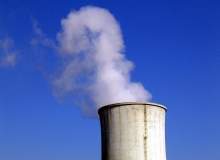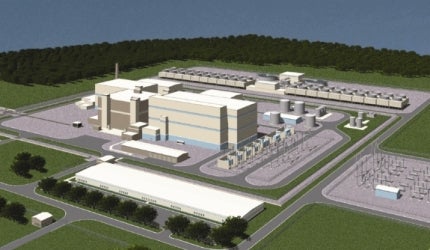

A major hidden cost of today’s nuclear power is the waste it produces. World stockpiles of depleted uranium from fuel processing are reported at 1.5 million tonnes, with another 350,000 tonnes of spent nuclear fuel still rich in radioactive material. This will need to be kept safe for thousands of years, despite economic and social conditions that are in many countries uncertain into even the next decade.
The Generation IV International Forum (GIF) has identified six types of new reactor to solve this and today’s other problems with nuclear power. They aim to reduce construction and running costs while improving sustainability, safety and reliability and resistance to weapons proliferation. Most designs will probably not be commercial before 2030 but some – assuming necessary licences – could start appearing in a decade.
One of the most promising is TerraPower’s Traveling Wave Reactor (TWR). It is a type of ‘fast breeder’: it works using fast rather than thermal neutrons, and breeds its own fuel. Started off with a relatively small amount of low-enriched material, the reactor runs on depleted uranium.
Nuclear waste then becomes a valuable resource. The next generation of nuclear reactors could thus run by extracting the energy left over in the spoils of the present nuclear generation.
The TWR is also known as a breed-and-burn or burning-wave reactor. A ‘burn wave’ is started with a small core of enriched fissile U-235 but continues with only fertile material like much more common depleted uranium U-238.

US Tariffs are shifting - will you react or anticipate?
Don’t let policy changes catch you off guard. Stay proactive with real-time data and expert analysis.
By GlobalDataFast breeder reactors – focusing on a unique core design
The breed-and-burn wave of the TWR does not itself move. Instead, the fuel in the core is moved in and out of the breed-burn region as a ‘standing’ wave. This fuel shuffling will be automatic, and won’t need the reactor to be opened.
The core has four zones. The localised fission zone concentrates the U-235 that decays producing fast neutrons. These are captured in the surrounding breeding zone, converting a fertile isotope like U-238 into a fissile isotope like Pu-239, which itself decays producing between two or three fast neutrons. The fresh zone contains unreacted fertile material, and the depleted zone contains mostly fission products and leftover fuel.
The reactor has a once-through (open) nuclear cycle. It operates at around 550°C, with the heat being removed by liquid sodium to drive steam turbines.
Major advantages over light water reactors
The light water reactors (LWRs) that make up the great majority of today’s working reactors use water as a moderator, to slow the fission neutrons to thermal speeds. That gives the best chance of causing further uranium fissions. The liquid sodium in the TWR conducts heat well but does not slow the neutrons, which are then more efficient at converting the U-238 into Pu-239.
Fast breeders use uranium more efficiently than thermal reactors like LWRs, which remove only 1% of the original ore’s fuel energy. They also have higher fuel density, burn-up rates and thermal efficiency.
Related feature
Europe’s nuclear stress tests: genuine safety accounts or political charade?
Stress tests conducted at European nuclear plants have found little wrong, but has enough been done post-Fukushima?
With the TWR, there is no need to refuel every 18 months. Its nuclear waste is similar to that from LWRs but there is less than a fifth of it, and it could start off new TWRs. Unlike other fast-neutron reactors, TWRs will run without needing enriched uranium or reprocessing to extract the plutonium.
The TWR aims to compete with coal on price. U-238 is much more common in nature and cheaper than conventional U-235. Using existing depleted uranium stockpiles as fuel would also eliminate the need for uranium mining. The reactor could alternatively use uranium extracted from seawater. Extraction is even now nearly economic, and this would give an immense alternative source. Future reactors could even run on natural uranium, thorium or spent fuel from LWRs.
The only way to test is by building a full scale reactor
TerraPower has modelled the process and is now producing detailed engineering plans for a 500-MWe reactor (TWR-D). The only real way to test the design is to produce a full-scale reactor.
Many of the elements have been tested elsewhere, and TerraPower has retained much of previous plant designs. Previous large-scale fast breeder power stations have also used liquid sodium cooling, for example, and the TWR is a pool type reactor (primary heat exchangers and pumps are immersed in the reactor tank) which is also well known.
The major difference lies in the core. This is approximately cylindrical and composed of hexagonally shaped fuel bundles. The fuel bundles contain a combination of enriched and depleted uranium metal alloy fuel pins clad in steel tubes. According to John Gilleland, CEO of TerraPower, “The only thing that stands in the way, before we can build a demonstration reactor, is the development of materials that surround the core – the cladding.”
TerraPower has studied ferritic and martensitic steels (two of the three main crystalline steel structures) for the cladding. “We need metals that can withstand an incredible amount of radiation for an extended time – beyond what current materials are designed to withstand. We’re working on this testing now, with partners in the US and Japan creating and testing these steel alloys.”
How the TWR holds up against other nuclear designs
The TWR’s nearest relative is the Candle reactor from the Tokyo Institute of Technology (also still at the design stage). In Candle, the fuel remains stationary and the burn wave moves through it.
Fast breeders in general were heavily researched until the 1970s when reserves of relatively cheap uranium were discovered. Previous experimental reactors could not compete with LWRs, and some have suffered from engineering problems. One prototype in the US (Enrico Fermi 1) suffered a partial meltdown. Research is still going ahead in several countries, though.
Related feature
Rise of a giant: Russia’s nuclear future
To double its nuclear hold by 2030, Russia will have to become a driving force in an industry struck by crisis. But can technological progress and increased international collaboration disperse the concerns about the country’s ageing power plants and safety standards?
Three of the six Gen IV reactors are fast breeders: cooled by gas, sodium and lead. (The other three types are the very high temperature gas reactor, SuperCritical water cooled reactor, and molten salt reactor.) Kirk Sorensen of Flibe Energy has described fast breeder reactors as hard to build and decommission, with the TWR being “particularly difficult”. Flibe Energy is itself developing a small liquid-fluoride thorium reactor (LFTR), a type of Gen IV molten salt reactor.
Such thorium reactors, too, have great promise. The element is inherently stable (fertile rather than fissile), and abundant in nature. Reactors can similarly burn existing nuclear wastes, and are proliferation-resistant.
Thorium can be used in several types of reactor. Besides in the TWR itself, that includes fast neutron reactors, heavy-water reactors like Candu (already commercialised) and – although not ideal – even pressurised (light) water reactors. There are still no full-scale prototypes, though, and commercialisation could still be 20 years away.
Can new nuclear reactors be built at reasonable costs?
Unless deployed on a huge scale, reactors will not make much inroad into nuclear waste stockpiles. So, the question is whether they can be built at reasonable cost.
Even Gen III reactors – not new designs but rather improved versions of current reactors – have run into problems. The 1.6 GWe Olkiluoto 3 European Pressurised Reactor (EPR) in Finland was going to be the showcase Gen III reactor. It was to have led to a series of identical, safe reactors delivered on-time and generating low cost electricity.
Related feature
India’s Electricity Generation Plans
India currently has 37 nuclear reactors planned or under construction, demonstrating the country’s commitment to plans to generate 25% of its electricity from nuclear energy by 2050.
Olkiluoto 3 was promised to come on line in 2009 at a cost of €2.5bn. It has hit construction problems, as have similar reactors in France and China. The power station is now not expected until 2014 and the latest cost estimate is over €6.5bn. Greenpeace remarks that the renewable project rejected in favour of the reactor was estimated at €3bn.
So, although the TWR is promising, it should not divert funding from renewable energy projects. John Gilleland acknowledges this: “Our effort does not take away from Generation III reactors or other Gen IV designs or even renewable energies. We would love to see a thousand initiatives in all these areas, and more than one solution will be needed to truly alleviate the world’s energy problem.”
Some of those solutions will have to be renewable ones, which nuclear will also have to compete with. Renewable costs are continually dropping, and for solar PV at an astounding rate. When TWR reactors are ready, they will be competing with solar (and other) renewables at 2020 prices and beyond.



